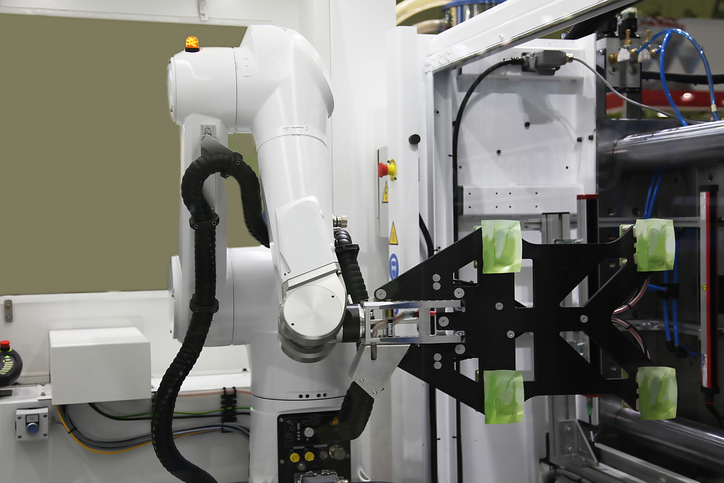Whether the end result is simple and straightforward, or complex and demanding, injection molding automation systems have carved out numerous advantages in today’s manufacturing and production environment.
Automated work cells, robotics, and rapidly-evolving end-of-arm tooling (EOAT) options are now critical elements of part and mold design, plastic injection molding, and operations both upstream and downstream of the molding process. The growth in automation solutions for injection molding rests with continually increasing technological advances, and the demand for manufacturing rising across the US.
For example, US manufacturing activity unexpectedly rose last month according to data released by The Institute for Supply Management. With new orders and output growth quickening, the underlying demand remains consistent.
With an eye on manufacturing expansion, while supply chain constraints and labor shortages provide negative impacts, many enterprises across several industries have turned to automation to meet demands. The plastics industry is no different; injection molding automation systems now offer solutions for proactive manufacturers and fabricators.
Let’s examine the reasons why automation makes sense for injection molding companies, what tasks it could be used for, and go in-depth on one particular tool enabling more production and better efficiency.
Expert Molding Assistance: Few molders can tackle the challenges of dealing with Torlon® PAI. Learn why, and how Ensinger Precision Components delivers, here.
The Benefits of Injection Molding Automation Systems
Effective integration of robotics and automation in plastic injection molding provides numerous advantages. Such additions to the manufacturing process ensure maximum quality of produced parts, reduce waste while adding efficiency, and help keep costs reasonable for the customer.
Consistent Part Quality
Injection molding automation systems add repeatability to tasks that deliver 100% accuracy every time — increasing and maintaining the quality of the production line. This is difficult for a human worker, who is more effective in other, more complex areas of the operation. With automation, exacting detail can be achieved on parts and processes in an infinitely repeatable manner.
Less Part-to-Part Variations and Waste
Automated processes create high volumes of products with minuscule error rates; this means there are fewer deformed parts and less waste because fewer parts are rejected. This not only helps reduce costs — less wasted materials for instance — but also aids in creating faster turnaround and fulfillment times, and leads to more sustainable manufacturing processes.
Reduced Labor and Part Costs
We touched on the reduced material expenses that come with injection molding automation systems, but such solutions typically lower the labor costs associated with manufacturing and fabrication as well. Robotic systems can handle work that previously needed multiple employees. They can fulfill the most repetitive and potentially dangerous tasks, allowing labor resources to be directed elsewhere to drive value.
Increased Utilization and Consistent Cycle Times
Automation systems can continue operating without interruption and properly maintained systems could run 24/7. This results in better per-unit production and quick order completion. Interconnected automated systems also generate analytical data that allows users to immediately notice problems, or identify areas for improvement.
Multiple Value-Adding Uses
Injection molding automation systems provide benefits outside the direct molding process as well. They can be used to handle newly molded parts, which may be delicate and vulnerable to deforming under pressure. Finely-tuned robotic tools can handle parts that need overmolding or further processing. Systems can be devised to feed plastic machining processes, pad printing, packaging, and more.
Loading and Unloading — Automated machinery uses the same amount of shot material per cycle, so products remain uniform. Robots can load or unload machines without error.
Visual Inspection — Robotic systems can orient the parts and use sensors to determine if their dimensional errors, and much more. Humans can oversee several cells at once.
Assembly/Sorting — Robotics can be used for complex tasks after the mold stage as well, such as welding assemblies, sorting parts for kits, and more.
Secondary Processes — Smart systems can use side-entry injection molding robots to perform tasks such as decorating and labeling quickly and accurately. Also, robotics are essential in consistent, efficient CNC machining processes.
Powering Essential Industries: Learn more about high-performance thermoplastics and why their characteristics are valued in demanding applications.
Take Advantage of Ensinger’s Injection Molding Automation Systems
Ensinger Precision Components has embraced the use of collaborative robots (cobots) in our injection molding production environment.
Cobots carry out many repetitive tasks, allowing the human workforce to oversee more than one machine and perform other higher-value tasks. The use of cobots allows for greater throughput and efficiency, due to many of the reasons cited above. Their adoption has enabled Ensinger to pull more work forward and get finished parts to customers sooner.
Ensinger Precision Components recently invested in a pair of cobots for machine tending duties; Each completing different tasks. One is used in secondary operations to guide machined parts on a CNC lathe. Capable of handling two pieces at once, this cobot picks up the part, places it into the CNC machine, signals the door to close, then starts the machine. Once the machining is finished, it removes the part and starts again.
At Ensinger, our second cobot is used in insert molding. It places the inserts into the injection molding machine, then removes the finished parts.
The implementation of injection molding automation systems is just one way Ensinger seeks to continuously improve and optimize its plastic manufacturing capabilities. With simulation software, a machine monitoring control system, CNC equipment, and a fully integrated ERP system, we remain committed to cutting-edge solutions that support your goals.
With more than 80 years of experience in high-performance thermoplastics, Ensinger Precision Components designs and manufactures solutions that exceed the demands of your specific applications.
